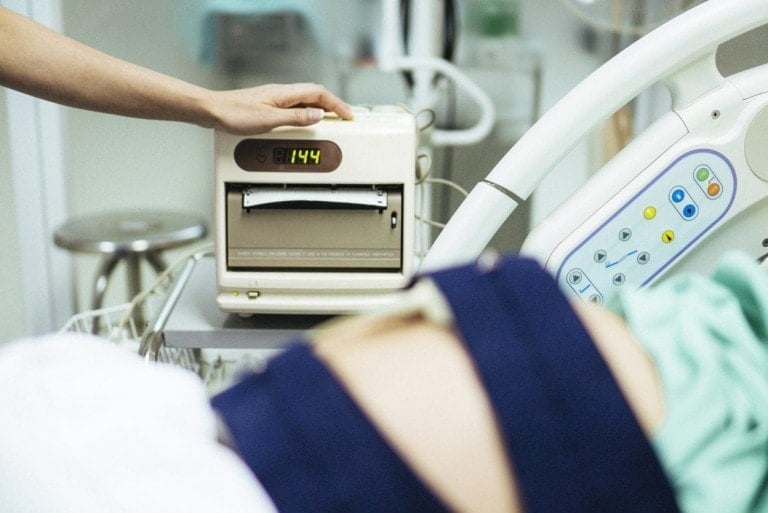The placenta is an organ that grows inside a mother’s uterus during pregnancy to nourish the baby. It connects to the baby via the umbilical cord and typically attaches to the uterus’s top, side, front, or back. The placenta provides oxygen and nutrients to your baby and removes its waste.1 Placenta accreta is a serious condition of pregnancy where the placenta attaches too deeply to the mother’s uterine wall. There are various types of this condition, with some being more severe than others.2
Placenta accreta is problematic because it leads to two major complications. The first is that the placenta does not deliver normally after birth because part or all of it is still attached inside a mother’s uterus. The second complication is that removing the placenta can lead to hemorrhaging (severe bleeding) for the mother.2
In some cases, blood transfusions, cesarean sections, special surgeries, and a possible hysterectomy (removal of the uterus) are necessary to ensure the mother and baby’s health.2,3,4 Obstetricians try to diagnose this condition during pregnancy using ultrasound or MRI imaging. But sometimes, it is not discovered until actual delivery begins.2
Types of Placenta Accreta
There’s a spectrum of severity with three main categories:2,5
- Placenta accreta: The placenta attaches deeper than usual to the uterine wall but doesn’t penetrate the uterine muscle.
- Placenta increta: The placenta attaches more deeply to the uterus and becomes embedded in the uterine muscle.
- Placenta percreta: The placenta attaches so deeply that it becomes attached to organs beyond the uterus, like the bladder.
Placenta previa is not a form of accreta, but it may coincide with it. This condition happens when a low-lying placenta covers the cervix.1,2
Placenta Accreta: Incidence Rates
According to the American College of Obstetricians and Gynecologists (ACOG), rates of placenta accreta spectrum are increasing. A 2016 study of women in the United States with a birth-related hospital discharge diagnosis found that the overall rate of this condition was one in 272. This rate was higher than any other previously published study on the topic.3
Risk Factors of Placenta Accreta
Several risk factors can contribute to a woman’s chance of developing this condition, including:1,2,4
- Previous uterine surgery: Past uterine surgery (or surgeries) — including a cesarean delivery (C-section), surgery to remove uterine fibroids, or surgeries near the uterus — can increase your risk.
- Placenta position: Placenta previa is a condition in which the placenta partially or fully covers the cervix. This indicates a low-lying placenta.
- Age of the mother: Placenta accreta is more common in women over the age of 35.
- Previous births: Prior childbirths increase a woman’s risk of developing placenta accreta.
Symptoms of Placenta Accreta
Placenta accreta can cause vaginal bleeding, particularly in the third trimester. It often does not show signs but can be detected via ultrasound.4 Tell your doctor early on if you’ve had multiple C-sections or surgery on or near your uterus. These can be potential risk factors for the development of placenta accreta.1,2 Sometimes, placenta accreta is not detected until childbirth is underway.2,3
Causes of Placenta Accreta
The exact cause of this issue is unknown. However, researchers believe that scarring in the uterine wall from prior cesarean sections or other uterine surgeries may play a role in advancing this irregularity.2,4
The American Pregnancy Association says that women who have had more than one C-section delivery account for 60% of all placenta accreta cases.5 Cases have also been linked to high alpha-fetoprotein levels, a protein the fetus makes that can be detected in a pregnant mother’s blood.3,6
Complications of Placenta Accreta
Here’s how this condition can affect the mother and baby:
Complications for the Mother
The primary concern for the mother is hemorrhaging. Hemorrhaging can occur when the placenta is manually operated on to remove it from the uterine wall or other organs it grew into. A hysterectomy to remove the uterus entirely may be necessary, but the results mean a mother cannot conceive afterward.2,5
Complications for the Baby
The primary concern for the infant is premature delivery and subsequent complications. These may include admission to the newborn intensive care unit or the baby becoming unstable (due to heavy bleeding making the mother unstable).2
Treatment for Placenta Accreta
Treatment plans vary from mother to mother, depending on the severity of the condition. In some cases, women may need bed rest several weeks before delivery, but this hasn’t been proven to help the issue.2,3,5 They may also schedule early delivery and/or a C-section. In severe cases of placenta accreta or risk of hemorrhaging, women may need a hysterectomy.2,3,4,5
According to ACOG, delivering in a maternity center with highly experienced staff and a coordinated care team is beneficial. They can provide additional expertise and resources if a mother’s severe hemorrhaging appears. This can improve the overall outcome for the mother.3
Work with your doctor, midwife, or healthcare team to determine the most advanced hospital or center in which you can deliver your child and choose the best path for managing your placenta accreta. Talking regularly with a therapist, doula, or counselor can also be a great way to relieve stress and manage your emotions.
Can You Prevent Placenta Accreta?
Unlike other conditions related to pregnancy, you cannot prevent placenta accreta.2,5 If you are experiencing any of the above symptoms, tell your doctor immediately so you can receive the proper treatment.
Placenta accreta is a serious issue that can lead to potentially life-threatening complications for the mother and complications for the baby. This is why you must talk to your doctor or a specialist and explore your treatment options. With the help of a team of experts, you can successfully manage situations involving this condition.





























